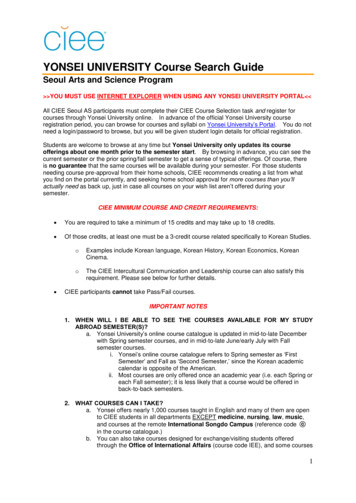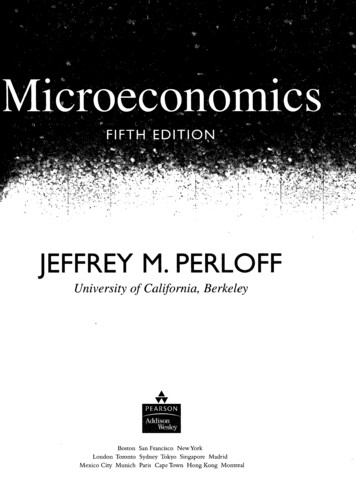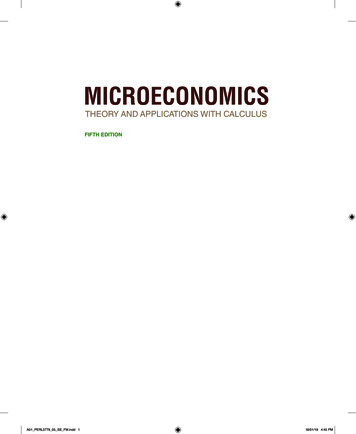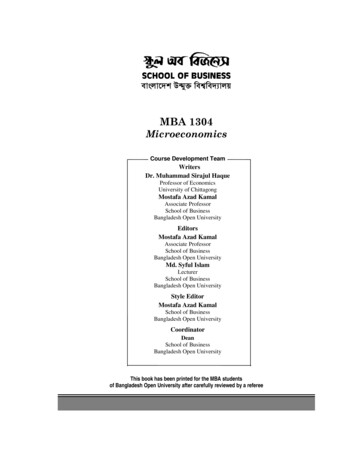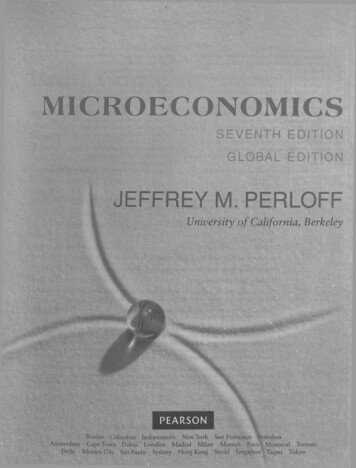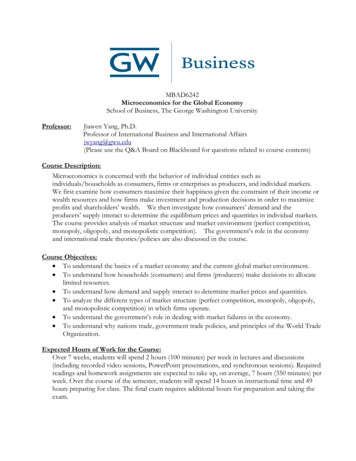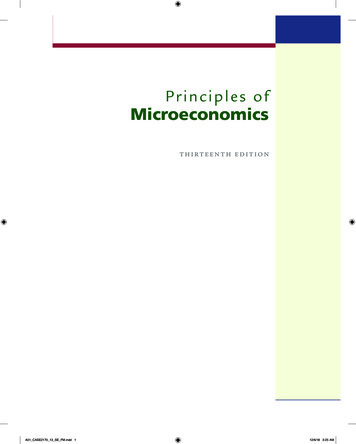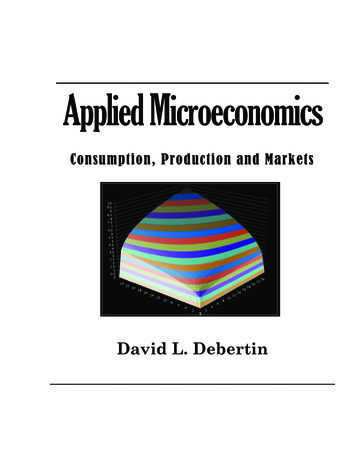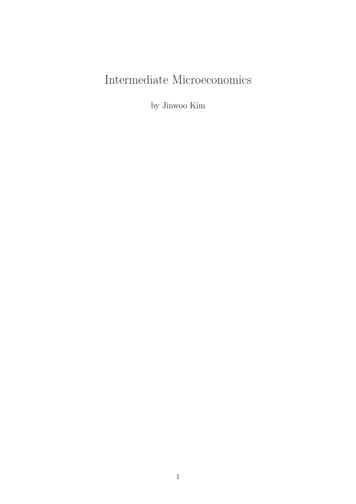
Transcription
Intermediate Microeconomicsby Jinwoo Kim1
Contents1 The Market42 Budget Constraint83 Preferences104 Utility145 Choice186 Demand247 Revealed Preference278 Slutsky Equation309 Buying and Selling3310 Intertemporal Choice3712 Uncertainty3914 Consumer Surplus4315 Market Demand4618 Technology4819 Profit Maximization5220 Cost Minimization5421 Cost Curves5722 Firm Supply5923 Industry Supply6224 Monopoly642
25 Monopoly Behavior6726 Factor Market7227 Oligopoly7628 Game Theory8030 Exchange853
Ch. 1. The MarketI. Economic model: A simplified representation of realityA. An example– Rental apartment market in Shinchon: Object of our analysis– Price of apt. in Shinchon: Endogenous variable– Price of apt. in other areas: Exogenous variable– Simplification: All (nearby) Apts are identicalB. We ask– How the quantity and price are determined in a given allocation mechanism– How to compare the allocations resulting from different allocation mechanismsII. Two principles of economics– Optimization principle: Each economic agent maximizes its objective (e.g. utility, profit,etc.)– Equilibrium principle: Economic agents’ actions must be consistent with each otherIII. Competitive marketA. Demand– Tow consumers with a single-unit demand whose WTP’s are equal to r1 and r2 (r1 r2 )pr2r112– Many people4Q
ppQQ consumers4 consumersB. Supply– Many competitive suppliers– Fixed at Q̄ in the short-runC. Equilibrium– Demand must equal supplypp p0Q̄Q0Q Eq. price (p ) and eq. quantity (Q̄)D. Comparative statics: Concerns how endogenous variables change as exogenous variables–change(Comparative: Compare two eq’aStatistics: Only look at eq’a, but not the adjustment process– For instance, if there is exogenous increase in supply, Q̄ Q0 , then p p05
III. Other allocation mechanismsA. Monopolypp0p QQ̄B. Rent control: Price ceiling at p̄ p Excess demand Rationing (or lottery)IV. Pareto efficiency: Criterion to compare different economic allocationsA. One allocation is a Pareto improvement over the other if the former makes some peoplebetter off without making anyone else worse off, compared to the latter.B. An allocation is called Pareto efficient(PE) if there is no Pareto improvement.Otherwise, the allocation is called Pareto inefficientC. Example: Rent control is not PE– Suppose that there are 2 consumers, A and B, who value an apt at rA and rB rA .– As a result of pricing ceiling and rationing, A gets an apt and B does not6
– This is not Pareto efficient since there is Pareto improvement: Let A sell his/her apt. toB at the price of p (rA , rB )BeforeAfterLandlordp̄p̄ArA p̄p p̄( rA p̄)B0rB p( 0) A and B are better off while no one is worse offD. An allocation in the competitive market equilibrium is PE7
Ch. 2. Budget Constraint– Consumer’s problem: Choose the ‘best’ bundle of goods that one ‘can afford’– Consider a consumer in an economy where there are 2 goods– (x1 , x2 ) : A bundle of two goods: Endogenous variable– (p1 , p2 ): Prices; m: Consumer’s income: Exogenous variableI. Budget set: Set of all affordable bundles p1 x1 p2 x2 mx2m/p2m/p2p1 the market exchange rate b/w the two goodsm/p1p2or ‘opportunity cost’ of good 1 in terms of good 2p1 /p2x1m/p1II. Changes in budget set– See how budget set changes as exogenous variables changeA. Increase in income: m m08
B. Increase in the price of one good: p1 p01C. Proportional increase in all prices and income: (p1 , p2 , m) (tp1 , tp2 , tm)※ Numeraire: Let t 1p1 x1 p2xp1 2 mp1that is, the price of good 1 is 1III. Application: Tax and subsidyA. Quantity tax: Tax levied on each unit of, say, good 1 bought– Given tax rate t, p01 p1 tB. Value tax: Tax levied on each dollar spent on good 1– Given tax rate τ , p01 p1 τ p1 (1 τ )p1C. Subsidy: Negative taxExample. s Quantity subsidy for the consumption of good 1 exceeding x̄19
Ch. 3. PreferencesI. Preference: Relationship (or rankings) between consumption bundlesA. Three modes of preference: Given two Bundles, x (x1 , x2 ) and y (y1 , y2 )1. x y: x ‘is (strictly) preferred to’ y2. x y: x ‘is indifferent to’ y3. x y: x ‘is weakly preferred to’ yExample. (x1 , x2 ) (y1 , y2 ) if x1 x2 y1 y2B. The relationships between three modes of preference1. x y x y or x y2. x y x y and y x3. x y x y but not y xC. Properties of preference 1. x y or y x2. Reflexive: Given any x, x x3. Transitive: Given x, y, and z, if x y and y z, then x zExample. Does the preference in the above example satisfy all 3 properties?※ If is transitive, then and are also transitive: For instance, if x y and y z,then x zD. Indifference curves: Set of bundles which are indifferent to one another10
1210x286A4B200246x181012※ Two different indifferent curves cannot intersect with each other※ Upper contour set: Set of bundles weakly preferred to a given bundle xII. Well-behaved preferenceA. Monotonicity: ‘More is better’– Preference is monotonic if x y for any x and y satisfying x1 y1 , x2 y2– Preference is strictly monotonic if x y for any x and y satisfying x1 y1 , x2 y2 , andx 6 yExample. Monotonicity is violated by the satiated preference:B. Convexity: ‘Moderates are better than extremes’– Preference is convex if for any x and y with y x, we havetx (1 t)y x for all t [0, 1]11
x2x2xxtx (1 t)ytx (1 t)yyyx1Convex Preferencex1Non-convex Preference Convex preference is equivalent to the convex upper contour set– Preference is strictly convex if for any x and y with y x, we havetx (1 t)y x for all t (0, 1)III. ExamplesA. Perfect substitutes: Consumer likes two goods equally so only the total number of goodsmatters 2 goods are perfectly substitutableExample. Blue and Red pencilB. Perfect complement: One good is useless without the other It is not possible to substitute one good for the otherExample. Right and Left shoe12
C. Bads: Less of a ‘bad’ is betterExample. Labor and Food※ This preference violates the monotonicity but there is an easy fix: Let ‘Leisure 24hours Labor’ and consider two goods, Leisure and Food.IV. Marginal rate of substitution (MRS): MRS at a given bundle x is the marginalexchange rate between two goods to make the consumer indifferent to x. (x1 , x2 ) (x1 x1 , x2 x2 ) MRS at x lim x2 x1 0 x1 slope of indifference curve at x MRS decreases as the amount of good 1 increases13
Ch. 4. UtilityI. Utility function: An assignment of real number u(x) R to each bundlexA. We say that u represents if the following holds:x y if and only if u(x) u(y)– An indifference curve is the set of bundles that give the same level of utility:U 10U 6U 410U u(x1 , x2 ) x1 x2U 8510A00B2468x15x21012 01210U 10x286U 8A4U 6B2U 400246x181012B. Ordinal utility14
– Only ordinal ranking matters while absolute level does not matterExample. Three bundles x, y, and z, and x y z Any u(·) satisfying u(x) u(y) u(z) is good for representing– There are many utility functions representing the same preferenceC. Utility function is unique up to monotone transformation– For any increasing function f : R R, a utility function v(x) f (u(x)) represents thesame preference as u(x) sincex y u(x) u(y) v(x) f (u(x)) f (u(y)) v(y)D. Properties of utility function– A utility function representing a monotonic preference must be increasing in x1 and x2– A utility function representing a convex preference must satisfy: For any two bundles xand y,u(tx (1 t)y) min{u(x), u(y)} for all t [0, 1]II. ExamplesA. Perfect substitutes1. Red & blue pencils u(x) x1 x2 or v(x) (x1 x2 )2 ( v(x) f (u(x)), where f (u) u2 )2. One & five dollar bills u(x) x1 5x23. In general, u(x) ax1 bx2 Substitution rate: u(x1 x1 , x2 x2 ) u(x1 , x2 ) x2 x1 abB. Perfect complements1. Left & right shoes(x1 if x2 x1 u(x) x2 if x1 x2or u(x) min{x1 , x2 }2. 1 spoon of coffee & 2 spoons of cream(x1 if x1 x22or u(x) min{x1 , x22 } or u(x) min{2x1 , x2 } u(x) x2x2if x1 223. In general, u(x) min{ax1 , bx2 }, where a, b 015
C. Cobb-Douglas: u(x) xc1 xd2 , where c, d 0dc1 v(x1 , x2 ) (xc1 cd2 ) c d x1c d x2c d xa1 x1 a2 , where a cc dIII. Marginal utility (MU) and marginal rate of substitution (MRS)A. Marginal utility: The rate of the change in utility due to a marginal increase in one goodonly– Marginal utility of good 1: (x1 , x2 ) (x1 x1 , x2 ) U1u(x1 x1 , x2 ) u(x1 , x2 ) lim( U1 M U1 x1 ) x1 0 x1 x1 0 x1M U1 lim– Analogously, U2u(x1 , x2 x2 ) u(x1 , x2 ) lim( U2 M U2 x2 ) x2 0 x2 x2 0 x2M U2 lim– Mathematically, M Ui u, xithat is the partial differentiation of utility function u x2for which u(x1 , x2 ) u(x1 x1 , x2 x2 ) x1 0 x1B. MRS lim 0 u(x1 x1 , x2 x2 ) u(x1 , x2 ) [u(x1 x1 , x2 x2 ) u(x1 , x2 x2 )] [u(x1 , x2 x2 ) u(x1 , x2 )] [u(x1 , x2 x2 ) u(x1 x1 , x2 x2 )] [u(x1 , x2 x2 ) u(x1 , x2 )] U1 U2 M U1 x1 M U2 x2 MRS x2M U1 u/ x1 x1M U2 u/ x2Example. u(x) xa1 x1 a2 MRS M U1axa 1 x21 aax2 a 1 a M U2(1 a)x1x1 (1 a)x2C. MRS is invariant with respect to the monotone transformation: Let v(x) f (u(x)) andthen v/ x1f 0 (u) · ( u/ x1 ) u/ x1 0 . v/ x2f (u)·( u/ x2 ) u/ x2Example. An easier way to get MRS for the Cobb-Douglas utility functionu(x) xa1 x1 a v(x) a ln x1 (1 a) ln x22So, M RS M U1M U2 a/x1(1 a)/x2 ax2(1 a)x1※ An alternative method for deriving MRS: Implicit function method16
– Describe the indifference curve for a given utility level ū by an implicit function x2 (x1 )satisfyingu(x1 , x2 (x1 )) ū– Differentiate both sides with x1 to obtain u(x1 , x2 ) u(x1 , x2 ) x2 (x1 ) 0, x1 x2 x1which yieldsM RS x2 (x1 ) u(x1 , x2 )/ x1 x1 u(x1 , x2 )/ x217
Ch. 5. Choice– Consumer’s problem:p 1 x1 p 2 x2 mMaximize u(x1 , x2 ) subject toI. Tangent solution: Smooth and convex preferencex2x is optimal:M U1p1 M RS M U2p2x x0 x2 x1p2 /p1– x0 is not optimal:M U1M U2 M RS x1p1p2 x2 x1or M U1 x1 M U2 x2 Better off withexchanging good 1 for good 2Example. Cobb-Douglas utility function)p1a x2M RS 1 a x1p2p 1 x1 p 2 x2 m (x 1 , x 2 ) am (1 a)m,p1p2II. Non-tangent solutionA. Kinked demandExample. Perfect complement: u(x1 , x2 ) min{x1 , x2 }18
)x1 x2p 1 x1 p 2 x2 m x 1 x 2 mp1 p2B. Boundary optimum1. No tangency:x2m/p2x At every bundle on the budget line,M RS x2p1p2or x1 · M U1 x2 · M U2 x (0, m/p2 )x00 x1 x2x0 x1x1Example. u(x1 , x2 ) x1 ln x2 , (p1 , p2 , m) (4, 1, 3)M RS x2 p1 4 x (0, 3)p22. Non-convex preference: Beware of ‘wrong’ tangencyExample. u(x) x21 x223. Perfect substitutes:19
(x 1 , x 2 ) (m/p1 , 0)if p1 p2any bundle on the budget line if p1 p2 (0, m/p )if p1 p22C. Application: Quantity vs. income tax Utility max. Quantity tax : (p t)x p x m (x 1 , x 2 ) satisfying p1 x 1 p2 x 2 m tx 1112 2Set R tx 1 Income tax : p1 x1 p2 x2 m R p1 x1 p2 x2 m tx 1 Income tax that raises the same revenue as quantity tax is better for consumers20
Appendix: Lagrangian MethodI. General treatment (cookbook procedure)– Let f and gj , j 1, · · · , J be functions mapping from Rn and R.– Consider the constrained maximization problem as follows:maxx (x1 ,···xn )f (x) subject to gj (x) 0, j 1, · · · , J.(A.1)So there are J constraints, each of which is represented by a function gj .– Set up the Lagrangian function as followsL(x, λ) f (x) JXλj gj (x).j 1We call λj , j 1, · · · , J Lagrangian multipliers.– Find a vector (x , λ ) that solves the following equations: L(x ,λ ) 0 for all i 1, · · · , n xi λj gj (x ) 0 and λ j 0 for all j 1, · · · , J.(A.2)– Kuhn-Tucker theorem tells us that x is the solution of the original maximization problemgiven in (A.1), provided that some concavity conditions hold for f and gj , j 1, · · · J. (Fordetails, refer to any textbook in the mathematical economics.)II. Application: Utility maximization problem– Set up the utility maximization problem as follows:maxu(x)x (x1 ,x2 )subject tom p 1 x1 p 2 x2 0x1 0 and x2 0.– The Lagrangian function corresponding to this problem can be written asL(x, λ) u(x) λ3 (m p1 x1 p2 x2 ) λ1 x1 λ2 x2A. Case of interior solution: Cobb-Douglas utility, u(x) a ln x1 (1 a) ln x2 , a (0, 1)21
– The Lagrangian function becomesL(x, λ) a ln x1 (1 a) ln x2 λ3 (m p1 x1 p2 x2 ) λ1 x1 λ2 x2– Then, the equations in (A.2) can be written asa L(x , λ ) λ 3 p1 λ 1 0 x1x1(A.3) L(x , λ )1 a λ 3 p2 λ 2 0 x2x 2(A.4)λ 3 (m p1 x 1 p2 x 2 ) 0 and λ 3 0(A.5)λ 1 x 1 0 and λ 1 0(A.6)λ 2 x 2 0 and λ 2 0(A.7)1) One can easily see that x 1 0 and x 2 0 so λ 1 λ 2 0 by (A.6) and (A.7).2) Plugging λ 1 λ 2 0 into (A.3), we can see λ 3 ap1 x 1 0, which by (A.5) impliesm p1 x 1 p2 x 2 0.(A.8)3) Combining (A.3) and (A.4) with λ 1 λ 2 0, we are able to obtainp1ax 2 (1 a)x1p2(A.9)4) Combining (A.8) and (A.9) yields the solution for (x 1 , x 2 ) ( am, (1 a)m), which we havep1p2seen in the class.B. Case of boundary solution: Quasi-linear utility, u(x) x1 ln x2 .– Let (p1 , p2 , m) (4, 1, 3)– The Lagrangian becomesL(x, λ) x1 ln x2 λ3 (3 4x1 x2 ) λ1 x1 λ2 x2– Then, the equations in (A.2) can be written as L(x , λ ) 1 4λ 3 λ 1 0 x1(A.10) L(x , λ )1 λ 3 λ 2 0 x2x2(A.11)λ 3 (3 4x 1 x 2 ) 0 and λ 3 0(A.12)λ 1 x 1 0 and λ 1 0(A.13)λ 2 x 2 0 and λ 2 0(A.14)22
1) One can easily see that x 2 0 so λ 2 0 by (A.14).2) Plugging λ 2 0 into (A.11), we can see λ 3 1x 2 0, which by (A.12) implies3 4x 1 x 2 0.(A.15)3) By (A.10),λ 1 4λ 3 1 4 1 0x 2since x 2 3 due to (A.15).4) Now, (A.16) and (A.13) imply x 1 0, which in turn implies x 2 3 by (A.15).23(A.16)
Ch. 6. Demand– We studied how the consumer maximizes utility given p and m Demand function: x(p, m) (x1 (p, m), x2 (p, m))– We ask here how x(p, m) changes with p and m?I. Comparative statics: Changes in incomeA. Normal or inferior good: xi (p,m) m 0 or 0B. Income offer curves and Engel curvesC. Homothetic utility function– For any two bundles x and y, and any number α 0,u(x) u(y) u(αx) u(αy).– Perfect substitute and complements, and Cobb-Douglas are all homothetic.– x is a utility maximizer subject to p1 x1 p2 x2 m if and only tx is a utility maximizersubject to p1 x1 p2 x2 tm for any t 0.– Income offer and Engel curves are straight lines24
D. Quasi-linear utility function: u(x1 , x2 ) x1 v(x2 ), where v is a concave function, thatis v 0 is decreasing.– Define x 2 to satisfyM RS 1v 0 (x2) p1p2(1)– If m is large enough so that m p2 x 2 , then the tangent condition (1) can be satisfied. The demand of good 2, x 2 , does not depend on the income level– If m p2 x 2 , then the LHS of (1) is always greater than the RHS for any x2 mp2 Boundary solution occurs at x (0, pm2 ).Example. Suppose that u(x1 , x2 ) x1 ln x2 , (p1 , p2 ) (4, 1). Draw the income offerand Engel curves.II. Comparative statics: Changes in priceA. Ordinary or Giffen good: xi (p,m) pi 0 or 0B. Why Giffen good? good 1 : x1 & Relatively more expensive(p1 % normal good: x1 & Reducedrealincome inferior good: x1 %So, a good must be inferior in order to be GiffenC. Price offer curves and demand curves25
D. Complements or substitutes: xi (p,m) pj 0 or 026
Ch. 7. Revealed PreferenceI. Revealed preference: Choice (observable) reveals preference (unobservable)((x1 , x2 ) chosen under price (p1 , p2 )– Consumer’s observed choice:(y1 , y2 ) chosen under price (q1 , q2 )A. ‘Directly revealed preferred ’ (d.r.p.)(x1 , x2 ) is d.r.p. to (y1 , y2 ) p1 x1 p2 x2 p1 y1 p2 y2B. ‘Indirectly revealed preferred ’ (i.r.p.)(x1 , x2 ) is i. r. p. to (z1 , z2 )C. ‘Revealed preferred ’ (r.p.) ‘d.r.p. or i.r.p.’II. Axioms of revealed preference:A. Weak axiom of reveal preference (WARP):– If (x1 , x2 ) is d.r.p. to (y1 , y2 ) with (x1 , x2 ) 6 (y1 , y2 ), then (y1 , y2 ) must not be d.r.p. to (x1 , x2 ) If p1 x1 p2 x2 p1 y1 p2 y2 with (x1 , x2 ) 6 (y1 , y2 ), then it must be that q1 y1 q2 y2 q 1 x1 q 2 x227
B. How to check WARP– Suppose that we have the following 2)(1,2)3(2,2)(1,1)– Calculate the costs of bundlesPrice \ Bundle123154 3 24 53 3664 WARP is violated since bundle 1 is d.r.p. to bundle 2 under price 1 while bundle 2 isd.r.p. to bundle 1 under price 2.C. Strong axiom of revealed preference (SARP) If (x1 , x2 ) is r.p. to (y1 , y2 ) with (x1 , x2 ) 6 (y1 , y2 ), then (y1 , y2 ) must not be r.p. to (x1 , x2 )III. Index numbers and revealed preference– Enables us to measure consumers’ welfare without information about their actual preferences(– Consider the following observationsBase year : (xb1 , xb2 ) under (pb1 , pb2 )Current year : (xt1 , xt2 ) under (pt1 , pt2 )A. Quantity indices: Measure the change in “average consumptions”ω1 xt1 ω2 xt2, where ωi is the weight for good i 1, 2ω1 xb1 ω2 xb2(Passhe quantity index (Pq ) if (ω1 , ω2 ) (pt1 , pt2 )– Using prices as weights, we obtainLaspeyres quantity index (Lq ) if (ω1 , ω2 ) (pb1 , pb2 )– Iq B. Quantity indices and consumer welfare– Pq pt1 xt1 pt2 xt2 1 : Consumer must be better off at the current yearpt1 xb1 pt2 xb2– Lq pb1 xt1 pb2 xt2 1 : Consumer must be worse off at the current yearpb1 xb1 pb2 xb228
C. Price indices: Measure the change in “cost of living”x1 pt1 x2 pt2, where (x1 , x2 ) is a fixed bundlex1 pb1 x2 pb2(Passhe price index (Pp ) : (x1 , x2 ) (xt1 , xt2 )– Depending on what bundle to use, we obtainLaspeyres price index (Lp ) : (x1 , x2 ) (xb1 , xb2 )– Ip – Laspeyres price index is also known as “consumer price index (CPI)”: This has problemof overestimating the change in cost of living29
Ch. 8. Slutsky Equation– Change of price of one good: p1 p01 with p01 p1(Change in relative price (p1 /p2 ) Substitution effect Change in real income Income effectI. Substitution and income effects:– Aim to decompose the change x1 x1 (p01 , p2 , m) x1 (p1 , p2 , m) into the changes due tothe substitution and income effects.– To obtain the change in demand due to substitution effect,(1) compensate the consumer so that the original bundle is affordable under (p01 , p2 ) m0 p01 x1 (p1 , p2 , m) p2 x2 (p1 , p2 , m)(2) ask what bundle he chooses under (p01 , p2 , m0 ) x1 (p01 , p2 , m0 )(3) decompose x1 as follows: x1 x1 (p01 , p2 , m) x1 (p1 , p2 , m) [x1 (p01 , p2 , m0 ) x1 (p1 , p2 , m)] [x1 (p01 , p2 , m) x1 (p01 , p2 , m0 )] {z} {z} xs1 : Change due to xn1 : Change due tosubstitution effectincome effectx2p01 x1 p2 x2 m0BA0O xn1 : IncomeeffectC0ADx1CTotal effect xs1 : Substitutioneffect30
x2BAA0x1OD C0C xs1 : Substitution xn1 : IncomeeffecteffectTotal effect xs : p11 0 Substitution Effect( xn1– Letting p1 p01 p1 , 0 if good 1 is normal p1 IncomeEffectn x1 0 if good 1 is inferior p1 In case of inferior good, if the income effect dominates the substitution effect, thenthere arises a Giffen phenomenon.Example. Cobb-Douglas with a 0.5, p1 2, & m 16 p01 4Remember x1 (p, m) amp1sox1 (p1 , p2 , m) 0.5 (16/2) 4, x1 (p01 , p2 , m) 0.5 (16/4) 2m0 m (m0 m) m (p01 p1 )x1 (p1 , p2 , m) 16 (4 2)4 24x1 (p01 , p2 , m0 ) 0.5 (24/4) 3 xs1 x1 (p01 , p2 , m0 ) x1 (p1 , p2 , m) 3 4 1 xn1 x1 (p01 , p2 , m) x1 (p01 , p2 , m0 ) 2 3 1II. Slutsky equation– Letting m m0 m, we have m m0 m (p01 p1 )x1 (p, m) p1 x1 (p, m)nA. For convenience, let xm1 x1 . Then, x1 xs1 xm xs1 xm11 x1 (p, m) p1 p1 p1 p1 mB. Law of demands (restated): If the good is normal, then its demand must fall as the pricerises31
III. Application: Rebating tax on gasoline:(x Consumption of gasolin–y Expenditure ( ) on all other goods, whose price is normalized to 1(t : Quantity tax on gasollin p0 p t–(x0 , y 0 ) : Choice after tax t and rebate R tx0– With (x0 , y 0 ), we have (p t)x0 y 0 m tx0 or px0 y 0 m (x0 , y 0 ) must be on both budget lines Optimal bundle before the tax must be located to the left of (x0 , y 0 ), that is the gasolineconsumption must have decreased after the tax-rebate policyIV. Hicksian substitution effect– Make the consumer be able to achieve the same (original) utility instead the same (original)bundlex2p1 p01 p1BA0OC0ADC(Hicksian) Income Effectx1(Hicksian) Substitution EffectTotal Effect32
Ch. 9. Buying and Selling– Where does the consumer’s income come from? Endowment (ω1 , ω2 )I. Budget constraintA. Budget line: p1 x1 p2 x2 p1 ω1 p2 ω2 Always passes through (ω1 , ω2 )B. Change in price: p1 : (x1 , x2 ) p01 : (x01 , x02 ) with p01 p1 x01 ω1 0 : Better off x1 ω1 0 * Consumer welfarex01 ω1 0 : Worse off x ω 01 1x0 ω 0 : ?11II. Slutsky equation– Suppose that p1 increases to p01 p1A. Endowment income effect– Suppose that the consumer chooses B under p1 and B 0 under p01x2B0B1B2BEx1A2A1 A0 A33
– The change in consumption of good 1 from A to A0 can be decomposed into A A1 : Substitution effectA1 A2 : Ordinary income effect A A0 : Endowment income effect2– A good is Giffren if its demand decreases with its own price with income being fixedB. Slutsky equation– The original bundle A (x1 , x2 ) would be affordable under (p01 , p2 ) and compensation m if m satisfiesp01 x1 p2 x2 p01 ω1 p2 ω2 m,from which m can be calculated asp01 x1 p2 x2 p01 ω1 p2 ω2 m p01 x1 p2 x2 p01 ω1 p2 ω2(p01 p1 )x1 (p01 p1 )ω1 m m p1 (ω1 x1 )– Then, the Slutsky equation is given as x1 xs1 xm xs1 xm xs1 xm11 m1 (ω1 x1 ) p1 p1 p1 p1 m p1 p1 m xs1 : Substitution effect p1m x1 ( x1 ) : Ordinary income effect decrease in real income by x1 p1 mm x1 ω1 : Endowment income effect increase in monetary income by ω1 p1 m34
III. Application: labor supply C : Consumption good p : Price of consumption good : Leisure time; L : endowment of time– w : Wage price of leisure M : Non-labor income C M/P : Consumption available when being idle– U (C, ): Utility function, increasing in both C and – L L , labor supplyA. Budget constraint and optimal labor supplypC M wL M pC wL pC w(L ) pC wl M wL pC wL {z }value of endowmente.g.) Assume U (C, l) C a 1 a , 0 a 1, M 0, and L 16, and derive the laborsupply curveB. Changes in wage: w w035
– Note that the leisure is not Giffen since the increase in its price (or wage increase) makesincome increase also– Backward bending labor supply curve: Labor supply can be decreasing as wage increases36
Ch. 10. Intertemporal Choice– Another application of buy-and-selling model– Choice problem involving saving and consuming over timeI. Setup– A consumer who lives for 2 periods, period 1 (today) and period 2 (tomorrow)– (c1 , c2 ): Consumption plan, ci consumption in period i– (m1 , m2 ): Income stream, mi income in period i– r: interest rate, that is saving 1 today earns (1 r) tomorrow– Utility function: U (c1 , c2 ) u(c1 ) δu(c2 ), where δ 1 is discount rate, and u is concave(that is u0 is decreasing)II. Budget constraint– s m1 c1 : saving( ) or borrowing( ) in period 1– Budget equation: c2 m2 (1 r)s m2 (1 r)(m1 c1 ), from which we obtain1c2c1 1{z r } present valueof consumptionplan (c1 , c2 )1m2 m1 1{z r } present valueof incomestream (m1 , m2 )※ Present value– Present value (PV) of amount x in t periods from now 37x(1 r)t
– PV of a job that will earn mt in period t 1, · · · , TTX mtm1m2mT ··· 1 r (1 r)2(1 r)T(1 r)tt 1– PV of a consol that promises to pay x per year for ever Xt 1xxx 1 r 1 t(1 r)r1 1 rIII. Choice– Maximize u(c1 ) δu(c2 ) subject to c1 1c1 r 2 m1 1m1 r 2– Tangency condition:u0 (c1 )M U11 slope of budget line 1 r0δu (c2 )M U21/(1 r)oru0 (c1 ) δ(1 r)u0 (c2 ) c c2 1 c1 c2 c c1238if (1 r) 1/δif (1 r) 1/δif (1 r) 1/δ
Ch. 12. Uncertainty– Study the consumer’s decision making under uncertainty– Applicable to the analysis of lottery, insurance, risky asset, and many other problemsI. Insurance problemA. Contingent consumption: Suppose that there is a consumer who derives consumption––––from a financial asset that has uncertain value:(bad state, with prob. πTwo statesgood state, with prob. 1 π(mb in bad stateValue of asset Endowmentmg in good state(consumption in bad state cbContingent consumptionconsumption in good state cg(K : Amount of insurance purchasedInsuranceγ : Premium per dollar of insurance– Purchasing K of insurance, the contingent consumption is given ascb mb K γK(2)cg mg γK(3)B. Budget constraint– Obtaining K mg cgγfrom (3) and substituting it in (2) yieldsm g cgγ(1 γ)(1 γ)cb cg mb mgγγcb mb (1 γ)K mb (1 γ)or39
II. Expected utilityA. Utility from the consumption plan (cb , cg ):πu(cb ) (1 π)u(cg ) Expected utility: Utility of prize in each state is weighted by its probability※ In general, if there are n states with state ioccurring with probability πi , then theexpected utility is given asnXπi u(ci ).i 1B. Why expected utility?– Independence axiomExample. Consider two assets as follows: State 1 : 1MA1State 2 : 0.5M State 3 : xorA2 State 1 : 1.5MState 2 : 0 State 3 : x Independence axiom requires that if A1 is preferred to A2 for some x, then it must bethe case for all other x.– According to Independence axiom, comparison between prizes in two states (State 1 and2) should be independent of the prize (x) in any third state (State 3)C. Expected utility is unique up to the affine transformation: Expected utility functionsU and V represent the same preference if and only ifV aU b, a 0D. Attitude toward risk– Compare (cb , cg ) and (πcb (1 π)cg , πcb (1 π)cg )Example. cb 5, cg 15 and π 0.5– Which one does the consumer prefers? Risk-loving Convex Risk-neutral πu(cb ) (1 π)u(cg ) u(πcb (1 π)cg u : Linear Risk-averse Concave Example (continued). u(c) c : concave 0.5 5 0.5 15 1040
uBu(Cg )Eu(πCb (1 π)Cg )πFπu(Cb ) (1 π)u(Cg )u(Cb )uDA1 πRisk premiumcCbCertainty equivalent to (Cb , Cg )CgπCb (1 π)CgRisk Averse Consumer– Diversification and risk-spreadingExample. Suppose that someone has to carry 16 eggs using 2 baskets with each basketlikely to be broken with half probability:(Carry all eggs in one basket : 0.5u(16) 0.5u(0) 2Carry 8 eggs in each of 2 baskets : 0.25u(16) 0.25u(0) 0.5u(8) 1 “Do not put all your eggs in one basket”III. Choice– Maximize πu(cb ) (1 π)u(cg ) subject to cb (1 γ)cgγ mb (1 γ)mgγ– Tangency condition:M Ubγπu0 (cb ) slope of budget line 0(1 π)u (cg )M Ug1 γ41 2
cgπ γ(mb , mg )Uπ γPπ γOγ1 γ45 cb π γ cb cg : Over-insured – π γ cb cg : Under-insuredπ γ cb cg : Perfectly-insured– The rate γ π is called ‘fair’ since the insurance company breaks even at that rate, orwhat it earns, γK, is equal to what it pays, πK (1 π)0 γK.42
Ch. 14. Consumer SurplusI. Measuring the change in consumer welfareA. Let CS change in the consumer surplus due to the price change p1 p01 p1– This is a popular method to measure the change in consumer welfare– The idea underlying this method is that the demand curves measures the consumer’swillingness to pay.B. This works perfectly in case of the quasi linear utility: u(x1 , x2 ) v(x1 ) x2– Letting p2 1 and assuming a tangent solution,v 0 (x1 ) M RS p1 x1 (p1 ) : demand function– So the demand curve gives a correct measure of the consumer’s WTP and thus CSmeasures the change in the consumer welfare due to the price change.– To verify, let x1 x1 (p1 ) and x01 x1 (p01 ), CS (p01 p1 )x01 R x1x01[v 0 (s) p1 ]ds (p01 p1 )x01 v(x1 ) v(x01 ) p1 (x1 x01 ) [v(x1 ) m p1 x1 ] [v(x01 ) m p01 x0 ]– However, this only works with the quasi linear utility.C. Compensating and equivalent variation (CV and EV)– Idea: How much income would be needed to achieve a given level utility for consumerunder difference prices?43
(– Letpo (p1 , 1), xo x(po , m), and uo u(xo )pn (p01 , 1), xn x(pn , m), and un u(xn )– Calculate m0 income needed to attain uo under pn , that is uo u(x(po , m0 )) define CV m m0 and say that consumer becomes worse(better) off as much asCV if m ( )m0 .– Calculate m00 income needed to attain un under po , that is un u(x(po , m00 )) define EV m m00 and say that consumer becomes worse(better) off as much asEV if m ( )m00 .x2m0p2 1p1 p01 p1CVmxCVxnxop01p1x1x2p2 1p1 p01 p1mEVm00xnxoxEVp01(Example.po (1, 1)pn (2, 1)p1x1(1/2 1/2, m 100, u(x1 , x2 ) x1 x20000(i) pn (2, 1) & m0 ( m4 , m2 ), u( m4 , m2 ) 00000000(ii) po (1, 1) & m00 ( m2 , m2 ), u( m2 , m2 )44 u0 u(50, 50) 50 un u(50, 25) 25 20m 50, so m0 1412 2 00 m2 25 2, so m00 70
– In general, CS is in between CV and EV– With quasi-linear utility, we have CS CV EVuo v(x1 ) m p1 x1 v(x01 ) m0 p01 x01un v(x01 ) m p01 x01 v(x1 ) m00 p1 x1 CV m0 m EV m m00 (v(x1 ) p1 x1 ) (v(x01 ) p01 x01 ) (v(x1 ) p1 x1 ) (v(x01 ) p01 x01 ) II. Producer’s surplus and benefit-cost analysisA. Producer’s surplus: Area between price and supply curve45
Ch. 15. Market DemandI. Individual and market demand– n consumers in the market– Consumer i’s demand for good k: xik (p, mi )– Market demand for good k: Dk (p, m1 , · · ·
Intermediate Microeconomics by Jinwoo Kim 1. Contents 1 TheMarket4 2 BudgetConstraint8 3 Preferences10 4 Utility 14 5 Choice 18 6 Demand 24 7 RevealedPreference27 8 SlutskyEquation30 9 BuyingandSelling33 10IntertemporalChoice37 12Uncertai


